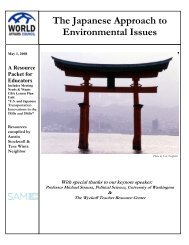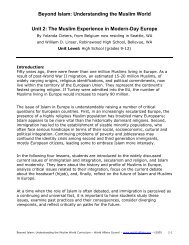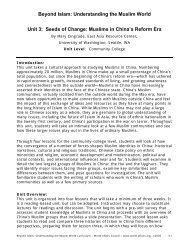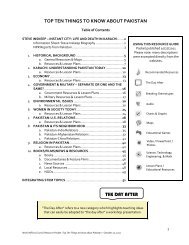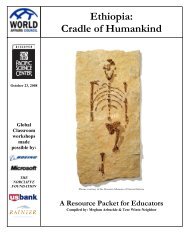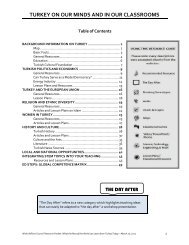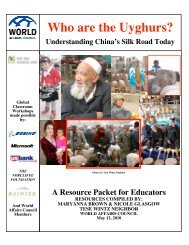The Question(s) of Tibet - World Affairs Council
The Question(s) of Tibet - World Affairs Council
The Question(s) of Tibet - World Affairs Council
You also want an ePaper? Increase the reach of your titles
YUMPU automatically turns print PDFs into web optimized ePapers that Google loves.
ENVIRONMENTAL ISSUES<br />
reduced to less than 75,000, due principally to poaching for shahtoosh. As many as 20,000<br />
<strong>Tibet</strong>an antelope are killed annually to supply the trade, with males, females and young<br />
slaughtered indiscriminately. <strong>The</strong> only way to obtain shahtoosh is to kill the chiru ‐‐ three to five<br />
dead antelope yield sufficient wool for one shawl. <strong>The</strong> chiru are skinned and the raw shahtoosh<br />
is collected and smuggled to India, where it is manufactured into shawls in the state <strong>of</strong> Jammu<br />
and Kashmir, the only location in the world where shahtoosh possession and manufacture are<br />
<strong>of</strong>ficially legalized.<br />
MOUNTAIN PATROL: KEKEXILI – 2004 (89 MINUTES)<br />
http://www.nationalgeographic.com/mountainpatrol/<br />
Mountain Patrol: Kekexili is a film inspired by a people's remarkable mission surrounding the<br />
illegal <strong>Tibet</strong>an antelope poaching in the region <strong>of</strong> Kekexili, the largest animal reserve in China.<br />
<strong>The</strong> story is brought to the screen with great detail by director Lu Chuan. Set against the<br />
exquisite backdrop <strong>of</strong> the Qinghai‐<strong>Tibet</strong>an Plateau, Chuan tells the tale <strong>of</strong> brave local <strong>Tibet</strong>ans<br />
who face death and starvation to save the endangered antelope herds from a band <strong>of</strong> ruthless<br />
hunters. <strong>The</strong> main cause <strong>of</strong> decline is hunting by humans. Also, habitat disturbance,<br />
hybridization, and competition with domestic yaks pose a threat to the species. <strong>The</strong> remaining<br />
wild yak population is legally protected, but according to the <strong>Tibet</strong> Forest Bureau, this is<br />
difficult to enforce in some mountainous regions. Some wild yaks are protected in the Chang<br />
Tang Reserve in China.<br />
CHANG TANG RESERVE (ESTABLISHED BY WILDLIFE CONSERVATION SOCIETY)<br />
http://www.wcs.org/saving‐wild‐places/asia/chang‐tang‐china.aspx<br />
<strong>The</strong> Chang Tang region is one <strong>of</strong> the last great expanses <strong>of</strong> wilderness left on Earth. Covering a<br />
good part <strong>of</strong> the <strong>Tibet</strong>an Plateau, this area <strong>of</strong> more than 400,000 square miles consists <strong>of</strong><br />
broad, rolling alpine steppes broken by hills, glacier‐capped mountains, and large basins<br />
studded with wetlands and saline lakes. <strong>The</strong> land is too cold to support forests and agriculture.<br />
Vegetation consists primarily <strong>of</strong> a sparse cover <strong>of</strong> grasses, sedges, forbs, and low shrubs. A<br />
significant portion <strong>of</strong> the northern Chang Tang is uninhabited by people, but the southern‐ and<br />
westernmost parts support <strong>Tibet</strong>an pastoralists and their livestock. Established with WCS’s<br />
help in 1993, the Chang Tang Nature Reserve is the second largest protected area on Earth. <strong>The</strong><br />
reserve covers approximately 115,000 square miles in the northwestern part <strong>of</strong> the <strong>Tibet</strong>an<br />
Autonomous Region <strong>of</strong> the People's Republic <strong>of</strong> China. It provides protection for a unique<br />
assemblage <strong>of</strong> wildlife, several species <strong>of</strong> which are endangered and endemic to the <strong>Tibet</strong>an<br />
plateau—such as the <strong>Tibet</strong>an gazelle, kiang, wild yak, wolf, snow leopard, and the <strong>Tibet</strong>an<br />
antelope, or chiru. Despite its remoteness, the Chang Tang region faces numerous threats that<br />
endanger the future <strong>of</strong> its wildlife, its rangeland ecosystems, and the <strong>Tibet</strong>an pastoralists. With<br />
the advent <strong>of</strong> roads, vehicles, and modern weapons, commercial and subsistence hunting has<br />
considerably depleted wildlife populations, especially the chiru. Hunters persecute chiru for<br />
their wool, known as shatoosh—the finest wool in the world. <strong>The</strong> numbers <strong>of</strong> pastoralists and<br />
their livestock are increasing, escalating potential conflicts with wildlife. Nomad groups that<br />
herded livestock on the open range are beginning to fence winter pastures, and some have built<br />
long fences across valleys and hills to keep wildlife out and livestock in. Permanent human<br />
settlements pose problems <strong>of</strong> over‐grazing, increased competition for forage between wildlife<br />
and livestock, and persecution <strong>of</strong> wildlife predators and pests.<br />
<strong>World</strong> <strong>Affairs</strong> <strong>Council</strong> Teacher Resource Packet – <strong>The</strong> <strong>Question</strong>(s) <strong>of</strong> <strong>Tibet</strong> February 28, 2011<br />
20



